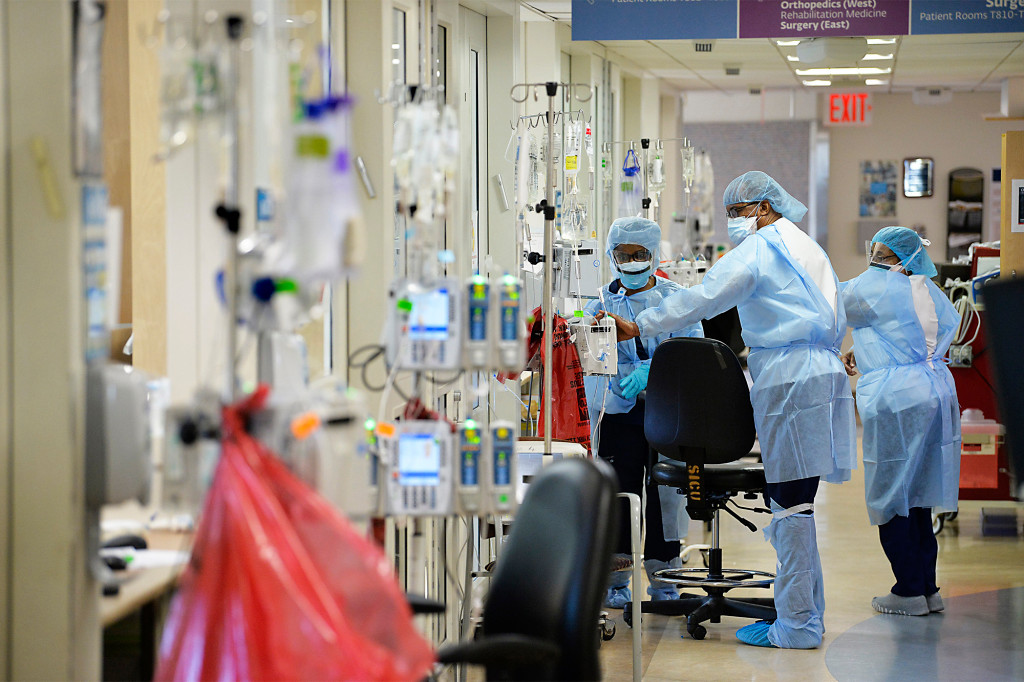Inside the Intensive Care Unit on the eighth floor of Maimonides Medical Center in Brooklyn, the IV drip bags are eerily out of place.
Instead of hanging on metal stands next to the patients’ beds, they’re all out in the hallway — with extra-long tubing delivering drugs, nourishment and fluids to critically ill coronavirus victims in rooms behind closed doors.
The drastic measure — which allows doctors and nurses to treat people without exposure to their deadly disease — was shown to The Post during an exclusive tour of the hospital as it braces for the expected “apex” of the outbreak in New York later this month.
Inside the ICU rooms, 26 patients were lying in beds on Tuesday, more than twice the normal caseload of just 12.
Most were older men and women, about three-quarters of whom were heavily sedated and attached to ventilators, mercifully unaware of the tubes stuck down their tracheas and the machines that keep their lungs working and their bodies alive.
But one young man — who appeared to be in his early 30s and otherwise fit, unshaven and with his brown hair in a crew cut — was awake and propped up on his bed.
A clear plastic oxygen mask was strapped to his face, and the silent hiss of the tank was his only companion as he stared with a desperate and forlorn look through the glass in the doors to his room.
“The most scary thing is to see how rapidly the patients deteriorate,” said Celeste Bethon, the Borough Park medical center’s vice president of nursing.
“When they deteriorate, they deteriorate very quickly. Their oxygen levels drop very quickly and it’s very difficult for us to get them back to where we want them to be.”
In addition to the ICU, The Post saw the hospital’s ground-floor Trauma Center, which resembled a beehive of activity as staffers hustled from stall to stall to triage and treat the steady stream of people arriving with symptoms of COVID-19.
Most of the dozen-plus patients observed in the unit’s north wing appeared listless or unconscious, and many were on ventilators.
The sound of amplified announcements filled the air every few minutes as doctors and nurses helped each other continually change each other’s surgical masks and other safety gear, to prevent infection of both them and any patients without the contagious respiratory illness.
Meanwhile, outside vendors shuttled in and out to replenish the unit with vital medical supplies.
Maimonides normally has a capacity of 711 beds, with about 10 percent of them devoted to critical care, said Dr. Patrick Borgen, chairman of its Department of Surgery and a specialist in treating breast cancer.
But since the coronavirus struck New York City — which quickly became the epicenter of the outbreak in the US — the Borough Park hospital has added about 200 more beds, and 250 are now filled with seriously sick patients, Borgen said.
“Before COVID, if you look at 2019, we saw about 115,000 patient visits,” he said.
“It’s really no telling what the number will be now.”
On Sunday, disturbing video — apparently shot by a hospital worker — was posted on YouTube that showed several wrapped bodies on gurneys on a sidewalk outside Maimonides, awaiting storage into a refrigerated trailer nearby.
A Maimonides spokeswoman confirmed the authenticity of the 41-second clip, saying, “We are doing what every hospital in New York City is doing in preparing for a surge in everything — patients who need care and a surge in patients who expire.”
Dr. Eitan Dickman, vice chairman of the Department of Emergency Medicine, described the hospital as “in a critical situation.”
 A flurry of activity inside Brooklyn’s Maimonides Hospital during the coronavirus pandemic.Matthew McDermott
A flurry of activity inside Brooklyn’s Maimonides Hospital during the coronavirus pandemic.Matthew McDermott
“There are a large number of critically ill patients who are requiring significant support in order to maintain their breathing status,” he said.
“And ensuring that front-line health care workers are safe and have the equipment that they need in order to take care of these patients is of utmost importance right now as priority No. 1.”
Dickman also acknowledged that, “Clearly, we’re going through a lot more supplies than you would during normal times, so we’re going to need to be getting some additional equipment.”
But Borgen said Maimonides had “left no stone unturned” in its quest to obtain masks, gloves, face shields and other PPE, adding, “For the foreseeable future, we are great.”
“One of our biggest fears is always ventilators for patients,” he said.
“We have a good cushion right now. But because we don’t know where the peak of this is going to be, we have to continually plan for the worst-case scenario.”
Dickman said it was unclear how much more devastation the coronavirus would wreak.
“We don’t know where we are on the curve. Is it going to be more of a steep curve? Are we flattening the curve?” he said.
Borgen said that while no Maimonides workers had stopped coming to work, “the fear, the anxiety, the apprehension is clearly there with the employees.”
“In most medical specialties, the doctors are not threatened personally by the disease,” he said.
“In this hospital, right now, everyone is threatened by the disease that they’re treating.”
Borgen also said he was loath to assign blame for the pandemic engulfing the US.
“The best infectious disease minds in the country, in January and February, didn’t really understand what was coming,” he said.
“When the federal government came to an understanding of what this was, I think the actions have been decisive and strong. We all regret that we didn’t see this sooner.”
Additional reporting by Matthew McDermott

































